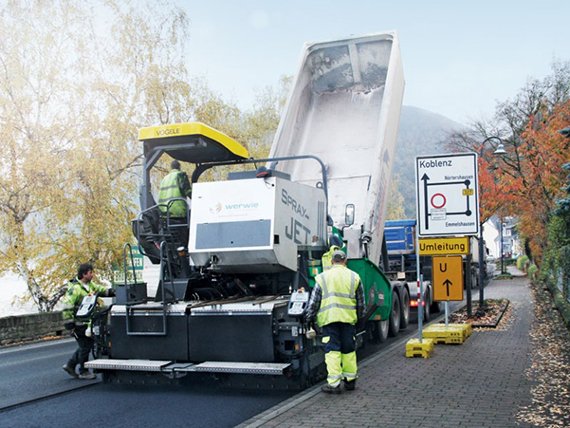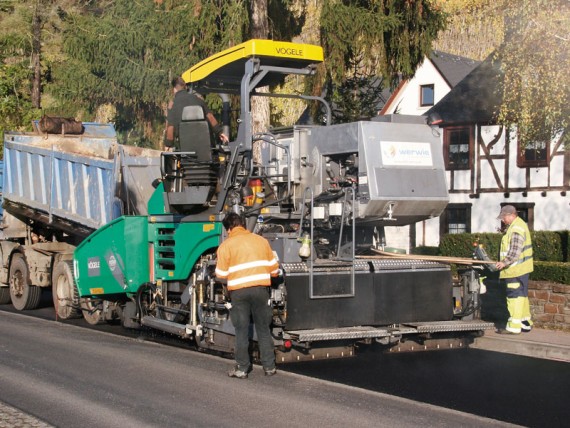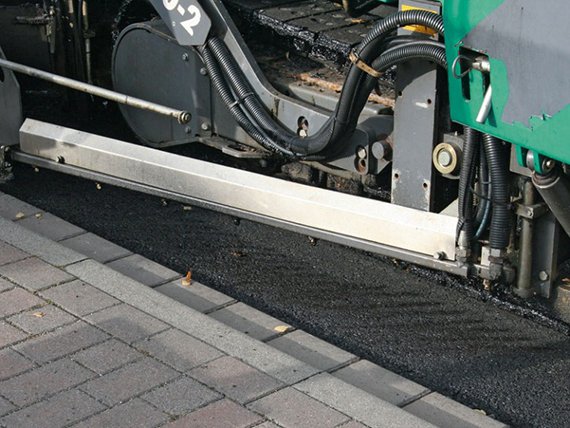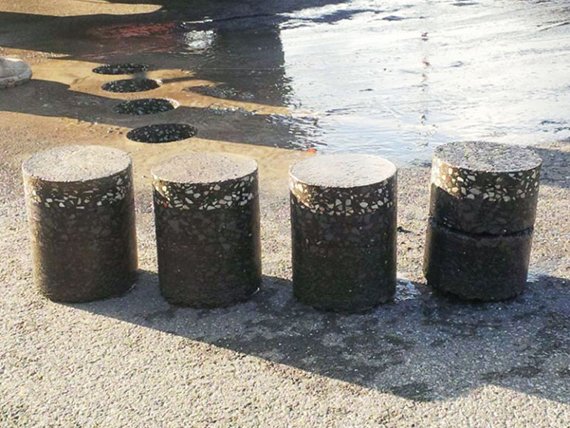SprayJet versus Conventional Paving with Pre-Spraying of Emulsion
A closed-textured bitumen film remains
after the process, which is subsequently overlaid with asphalt. The
considerable time and equipment required is a disadvantage of this
conventional method. A further problem is that the surrounding areas,
roads and curbs are fouled with emulsion by job site vehicles. These
problems are now a thing of the past thanks to SprayJet technology from
VÖGELE. With the SprayJet, the fresh emulsion is directly overlaid with
asphalt as soon as it is sprayed.
This saves a great deal of time, since
there is no longer any need to bring the work to a halt for some 12
hours while the emulsion breaks. What’s more, the spray nozzles can be
set precisely to prevent fouling of the adjacent areas. But is the bond
between layers achieved with the SprayJet method just as strong as that
produced by conventional pre-spraying? The two paving methods were
compared on behalf of the State Office for Mobility,
Rhineland-Palatinate (Landesbetrieb Mobilität Rheinland-Pfalz) when a
section of the B 49 federal road in Brodenbach near Koblenz, Germany,
was rehabilitated. One aspect to be investigated was whether the bond
between layers is impaired by the water content of the unbroken bitumen
emulsion when the base is sprayed immediately before paving. To this
end, drill cores were taken and analysed.


Brodenbach is located in an area of
Rhineland-Palatinate known as the “Terassenmosel” (terraced slopes along
the river Moselle) in the district of Mayen-Koblenz, about 26km south
of Koblenz. The B 49 federal road runs straight through this popular
tourist resort. It offers travellers a picturesque view of the river
Moselle. However, long years of heavy traffic and patchwork repairs had
taken a heavy toll, leaving the road in urgent need of pavement
rehabilitation. At the same time, the work had to proceed without unduly
impairing tourist traffic; for this reason, only one lane could be
closed to traffic at any one time.

A 1,200m-long stretch of this heavily
frequented road with a traffic load of over 6,900 vehicles per day was
to be rehabilitated. In keeping with the load class Bk 3.2, the roadway
was to be given the following structure: bitumen emulsion C60BP1-S,
300g/m2, = 5cm asphalt binder course AC 16 B S, bitumen emulsion
C60BP1-S, 200g/m2 and 4cm asphalt surface course AC 11 D S. The existing
pavement was removed in several sections, with traffic being diverted
over only one half of the road; the same also applied when paving the
binder course and surface course. Since the milled surfaces were not
homogeneous and unsuitable for use by through-traffic, the work had to
proceed in three 400m sections.
The project as a whole was subdivided into four sections in order to
permit representative comparison of the methods. SprayJet technology was
used in work sections 1 – 3. Binder and surface courses were paved
using the conventional method with pre-spraying of emulsion in work
section 4.
The bond of layers proves that the SprayJet method produces the same quality
The quality of the bond between layers
is one of the most significant criteria for assessing the durability of a
road. Shear strength and shearing distance are representative
parameters when it comes to forecasting durability. A total of 16 drill
cores were taken under official supervision in Brodenbach: four from the
section with conventional pre-spraying of emulsion and twelve from the
“SprayJet sections”.
Result: both conventional paving and paving with SprayJet technology
yielded good results when the bond between layers was analysed.

Drill core analyses proved the high quality of the SprayJet method.
Conclusion: VÖGELE SprayJet technology is an excellent alternative to conventional paving with pre-spraying of emulsion
As the practical test in Brodenbach showed, a VÖGELE spray paver is also
a faster and more cost-efficient option for paving the binder and
surface course in the conventional way with pre-spraying. The spray
paver saves time because there is no need to wait a long time for the
emulsion to “break”. What’s more, there is no danger of the sprayed
surface being driven over or fouled by other means; the same also holds
for adjacent traffic areas used by the job site vehicles. This
eliminates the need for a “big clean-up” afterwards. Most importantly of
all, the quality of the bond between layers is also better, as the
analysis of the drill cores from Brodenbach proved.

Mark of quality: the rate of spread can be set precisely on the SprayJet
module. A perfect sprayed surface is guaranteed at all times.
Even when working conventionally and
pre-spraying emulsion, the VÖGELE spray pavers really deliver on
cost-efficiency and pavement quality. And they also have yet another
advantage: these machines are quickly and easily converted to standard
pavers without the spraying function. This improves their capacity
utilization and profitability still further.
Heribert Müssenich, Group Team Leader, Road Construction Technology in
the State Office for Mobility, Rhineland-Palatinate (Landesbetrieb
Mobilität Rheinland-Pfalz) who supervised the comparison of methods in
Brodenbach, summed it up as follows:
“SprayJet technology has definitely proved its value when paving conventional asphalt mixes.”
Công nghệ khác
VÖGELE Get the Job Done Accurate to the Millimetre
“AutoSet Plus” is Quality Assurance at the Press of a Button